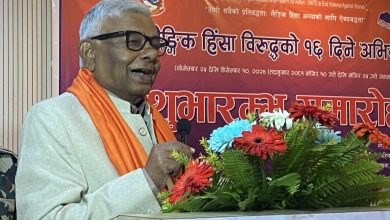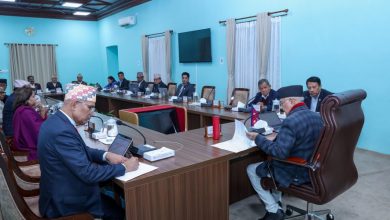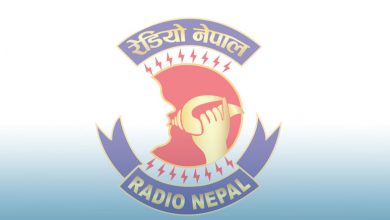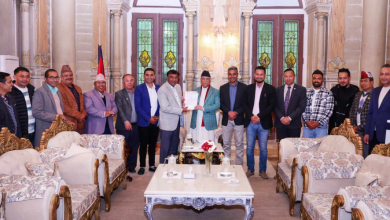‘Indigenous communities suffer the worst from disasters’
Kathmandu: The Mid-Hill Highway is under construction along the village of Sindurechaur in Bhumlu Rural Municipality-8 in Kavre district.
The Majhi settlement in the village was at risk when the track of the national pride project was constructed some two years ago. Making things worse landslides that occurred following the torrential rain this September washed away the village itself.
In the disaster, Ram Bahadur Majhi lost his 51-year-old mother while his house too collapsed. Jit Bahadur Majhi is also not an exception. His house was destroyed in the landslide.
The impoverished and marginalized Majhi families were earning their lives from daily wages. Furthermore, the Majhi families have no option for fishing, a traditional occupation of the Majhi community, for lack of fishing sites as the local government issues tenders for extracting stones, pebbles and sands from the rivers.
Chairperson of Bhumlu Rural Municipality-8, Motilal Tamang, said the limited land they own is insufficient even to produce food for four months a year. ‘The landslide caused after the construction of the Mid Hill Highway has now displaced us and taken the life of a person,’ Tamang said.
The landslide that occurred this September caused the highest human toll in Roshi Rural Municipality in the district, leaving 14 persons dead from a ward including five persons from a single family.
Chairperson of Roshi Rural Municipality-4 Tej Bahadur Magar said four members of Chandra Bahadur Tamang died while three members of the family were lucky to survive the disaster. In such incidents of disasters, economically poor families have suffered the worst.
Likewise, 15 houses of the Sherpa community were destroyed in the disaster that happened in August after the glacial lake burst in Thame village in Solukhumbu district.
Despite limited relief from the government, the displaced families are yet to resettle as their property worth millions was damaged. The above three cases shed a clear picture of how the indigenous nationalities were affected physically and on a humanitarian level by the natural disasters this year.
The indigenous communities are always at high risk of natural disasters and this year’s monsoon-induced disasters too support this claim. Indigenous communities make up 41.54% of fatalities in monsoon-induced disasters.
In the disasters that took place from Baisakh to Asoj (May-June to September-October) this year, there were 443 fatalities, with 184 casualties (41.54%) from indigenous communities. According to data from the National Emergency Operation Centre, four victims remain unidentified, and 66 people are still missing.
Among the total fatalities, 228 were women and girls, making up 51.47% of the deaths. Of these, 60 were children—35 boys and 25 girls—accounting for 13.55% of the total fatalities. The province-wise distribution of deaths shows that Bagmati Province recorded the highest number of fatalities, with 267 deaths, followed by Gandaki (55), Koshi (43), Lumbini (29), Karnali and Sudurpaschim (16 each), and Madhesh Province (13).
Experts on climate change have suggested that the monsoon-induced disasters, particularly the unseasonal rains between Asoj 11-17 (September 27 to October 2), are a consequence of climate change. In September-October alone, 303 lives were lost due to these disasters.
Kavrepalanchowk District suffered the highest loss, with 79 deaths, 78 injuries, and six people missing. However, the comprehensive report on the damages is still awaited, according to Assistant Chief District Officer Subash Paudel.
Among the 79 deaths in Kavre, 38 were from indigenous communities, accounting for 48.11% of the fatalities. Of these, three were from the Majhi community, two from the Magar community, one from the Shrestha community, and 32 from the Tamang community.
As per the 2021 national census (2078 BS), the total population of indigenous communities is 10,218,570, or 35.04% of the country’s population. The data indicates that Indigenous communities are more vulnerable to natural disasters and their devastating consequences.
Paudel shared that the traditional skills and practices of the indigenous communities are closely linked with nature; thereby making them the first communities to bear the brunt of adverse effects of climate change or natural disasters.
According to him, the tribal communities still like to employ traditional skills and knowledge rather than science and technology in their daily life activities. Indigenous rights defenders argue that although Nepal has reaffirmed its commitment to promote the rights of Indigenous communities on paper by signing in many international conventions on Indigenous communities, the State has been indifferent towards Indigenous communities in practice.
Nepal Federation of Indigenous Nationalities’ (NEFIN) President Gelje Sherpa shared that the Indigenous communities across the world chanted slogans and staged demonstrations throughout the global climate conference in the COP-29 recently held in Baku Azerbaijan.
It may be noted that the world gathering of some 50,000 people ranging from Heads of State and Head of Governments from 197 countries ratifying the United Nations Framework Convention on Climate Change had convened at the global climate conference to deliberate on the most pressing issues change- and to take collective climate actions.
NEFIN President Sherpa lamented the apathy of the States worldwide over the Indigenous communities’. “Although the native communities are hardest hit by climate change impacts, they are far from climate compensation,” he decried, stating that they have been continuously striving against that prejudice-laden treatment.
Furthermore, he denounced the lack of consideration towards the Indigenous communities while allocating the budget the State receives for reducing carbon emissions. He foresees several challenges facing the effective implementation of the National Climate Change Policy 2076 BS.
RSS









Comments